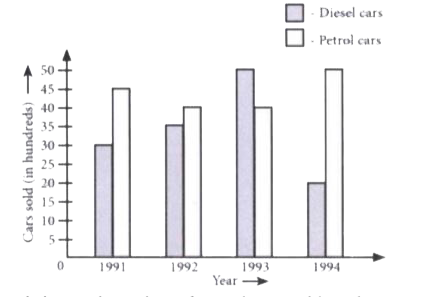Directions : Read the following and answer the questions that follow.
Two friends Shayam and Kailash own two versions of a car. Shayam owns the diesel version of the car, while Kailash owns the petrol version. Kailash's car gives an average that is 20% higher than Shayam's in terms of litres per kilometer). It is known that petrol costs 60% of its price higher than diesel.
The ratio of the cost per kilometer of Kailash's car to Shayam's car is
A)
B)
C)
D)
The correct Answer is:A
To solve the problem step by step, we will analyze the information given about the two cars owned by Shyam and Kailash.
Step 1: Define the Mileage
Let's assume Shyam's car (diesel) has a mileage of MS liters per kilometer. According to the problem, Kailash's car (petrol) has a mileage that is 20% higher than Shyam's. Therefore, we can express Kailash's mileage MK as:
MK=MS+0.2×MS=1.2×MS
Step 2: Assign Values to Mileage
For simplicity, let's assume Shyam's car gives a mileage of 5 liters per kilometer:
MS=5 liters/km
Then Kailash's mileage will be:
MK=1.2×5=6 liters/km
Step 3: Define the Cost of Petrol and Diesel
Let the cost of diesel be D units. According to the problem, petrol costs 60% more than diesel. Therefore, the cost of petrol P can be expressed as:
P=D+0.6D=1.6D
Step 4: Calculate Cost per Kilometer
The cost per kilometer for each car can be calculated using the formula:
Cost per kilometer=Cost of fuelMileage
For Shyam's car:
Cost per kilometer for Shyam=DMS=D5
For Kailash's car:
Cost per kilometer for Kailash=PMK=1.6D6
Step 5: Simplify the Cost per Kilometer for Kailash
Now, we simplify the cost per kilometer for Kailash:
Cost per kilometer for Kailash=1.6D6=0.8D3
Step 6: Find the Ratio of Cost per Kilometer
Now, we need to find the ratio of the cost per kilometer of Kailash's car to Shyam's car:
Ratio=Cost per kilometer for KailashCost per kilometer for Shyam=0.8D3D5
This can be simplified as follows:
Ratio=0.8D3×5D=0.8×53=43
Final Step: Present the Ratio
Thus, the ratio of the cost per kilometer of Kailash's car to Shyam's car is:
Ratio=43
Conclusion
The final answer for the ratio of the cost per kilometer of Kailash's car to Shyam's car is 4:3.
---
Let's assume Shyam's car (diesel) has a mileage of MS liters per kilometer. According to the problem, Kailash's car (petrol) has a mileage that is 20% higher than Shyam's. Therefore, we can express Kailash's mileage MK as:
MK=MS+0.2×MS=1.2×MS
For simplicity, let's assume Shyam's car gives a mileage of 5 liters per kilometer:
MS=5 liters/km
Then Kailash's mileage will be:
MK=1.2×5=6 liters/km
Let the cost of diesel be D units. According to the problem, petrol costs 60% more than diesel. Therefore, the cost of petrol P can be expressed as:
P=D+0.6D=1.6D
The cost per kilometer for each car can be calculated using the formula:
Cost per kilometer=Cost of fuelMileage
For Shyam's car:
Cost per kilometer for Shyam=DMS=D5
For Kailash's car:
Cost per kilometer for Kailash=PMK=1.6D6
Now, we simplify the cost per kilometer for Kailash:
Cost per kilometer for Kailash=1.6D6=0.8D3
Now, we need to find the ratio of the cost per kilometer of Kailash's car to Shyam's car:
Ratio=Cost per kilometer for KailashCost per kilometer for Shyam=0.8D3D5
This can be simplified as follows:
Ratio=0.8D3×5D=0.8×53=43
Thus, the ratio of the cost per kilometer of Kailash's car to Shyam's car is:
Ratio=43
The final answer for the ratio of the cost per kilometer of Kailash's car to Shyam's car is 4:3.
Topper's Solved these Questions
- BOOK - ADDA247CHAPTER - PROFIT AND LOSSEXERCISE - Previous Year Questions30videos
PROFIT AND LOSS
- BOOK - ADDA247CHAPTER - PROFIT AND LOSSEXERCISE - Prelims Questions (Level-2)40videos
PROFIT AND LOSS
- BOOK - ADDA247CHAPTER - PERMUTATION ,COMBINATION AND PROBABILITY EXERCISE - Previous Year Question25videos
PERMUTATION ,COMBINATION AND PROBABILITY
- BOOK - ADDA247CHAPTER - RATIO & PROPORTION AND PARTNERSHIP EXERCISE - PREVIOUS YEAR QUESTIONS20videos
RATIO & PROPORTION AND PARTNERSHIP
Similar Questions
Study the graph and answer the question.

In which year, were the exports of type B cars exactly 20% more than the exports of type A cars in 2014?View SolutionStudy the graph and answer the question

In which year, were the exports of type B cars exactly 20% more than the exports of type A cars in 2014?View Solution
Knowledge Check
- Question 1 - Select One
There will be a _______ in the demand curve of cars with an increase in the price of petrol :
ARightward shiftBUpward MovementCLeftward shiftDDownward Movement - Question 2 - Select One
A trader wishes to gain 20% after allowing 10% discount on the marked price to his customers. At what per cent higher than the cost price must he marks his goods ?
A30%B3313%C3423%D35% - Question 3 - Select One
The cost of car is 400% greater than the cost of a bike . If there is an increase in the cost of the car is 15%and that of bike is 20%. Then the total increase in the cost of the 5 cars and 10 bikes is :
A17.5%B1637%C18.5%D18.25%
The cost of a car is 400% greater than the cost of a bike. If there is an increase in the cost of the car is 15% and that of bike is 20%. Then the total increase in the cost of the 5 cars and 10 bikes is :
View SolutionSelling price of a toy car is Rs. 540. If the profit made by shop keeper is 20%, what is the cost price of this toy?
View SolutionA shopkeeper marks his goods 20% higher than the cost price and allows a discount of 5%. The percentage of his profit is
View SolutionStudy the graph carefully and answer the following questions.

How many more Diesel cars were sold in 1991 than in 1994?View SolutionThe marked price is 20% higher than cast price. A discount of 20% is given on the marked price. By this type of sale, there is -
View Solution
